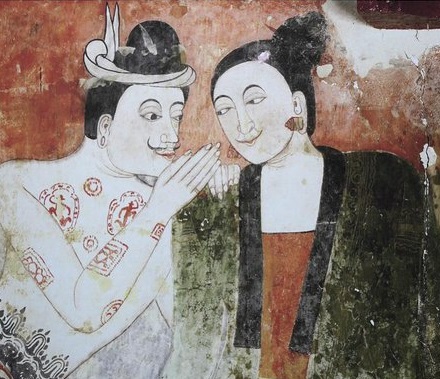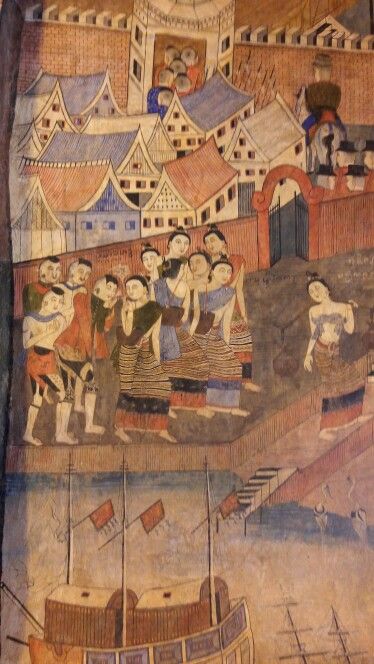Nan is a Thai town with a very unusual history. Though it is counted as one of the northern provinces of Thailand, it is located much closer to the Lao border than the former Lanna capital of Chiang Mai, and it has a distinct identity to match its isolated location within Thailand. It was long an autonomous principality which drew as much influence from Xishuangbanna in China as from the Lanna settlements of Northern Thailand. This history of seclusion and separation is very much reflected in its arts and architecture. While the artistic heritage of Lanna is clearly in evidence, you will also see the influence of the Tai Lü, a group whose ancestral homeland is Xishuangbanna district of Yunnan Province in China. There influence is best appreciated by visiting Wat Phumin, which is often regarded as the most extraordinary of Nan’s outstanding collection of wats.
The history of Wat Phumin dates back to 1596 when the wat was first built. It has a highly unusual form; indeed, it is utterly unique in all of Thailand. The wat is designed with a cruciform shape and staircases extend out on all four sides with elaborate nagas for balustrades. This makes it seem as if the entire wat is riding on the back of two gigantic nagas. Besides the staircase sit two even larger guardian figures- a pair of brick and stucco lions which guard the temple from malign spirits. Apart from that, it is has a multi-tiered roof but this does not sweep low down to the ground like those from Luang Prabang and Chiang Mai, remaining a series of horizontal lines. The other unmissable thing is the entrance doors, which are masterpieces of Lanna woodcarving. Every inch of the doors is filled in which intricately carved motifs, many of them floral. Yet its beautiful form notwithstanding, it is the interior of the temple which has earned it such widespread fame within Thailand.
The visitor to a Thai wat will usually expect to see one main Buddha image inside the hall. If it is a famous historic wat, these images will usually be of great artistic or historic value, often dating back to one of the great historic kingdoms of the Thai past. However, in Wat Phumin there are not one but four main Buddha images, with one oriented towards each of the four entrance doorways. Each of the four Buddhas are seated on a high pedestal in the bhumisparsha posture, which is also known as the ‘earth-touching’ position. They are surrounded by four enormous teak pillars which support the roof. The whole tableau is very impressive and atmospheric, with the seated Buddhas dominating the central space of the wat. However, it is also not this central tableau which is Wat Phumin’s main source of fame. That distinction goes to the folksy murals which decorate the walls of the wat in such vivid detail.

The murals of this temple are very famous in Thailand, and entire books have been devoted to describing and commenting on them. In this blog post I have no intention of analyzing, classifying or describing them in any detail. All I intend to do here is offer the broadest of overviews or introductions. Basically, the murals were painted during the second half of the nineteenth century by a Tai Lü artist, and they represent one of the finest examples of extant mural art surviving in Thailand. Rendered in vegetable pigments, they have lovely, rich, earthy colours which are a marked contrast with the more fluorescent colours of modern Bangkok wats. But what really makes them so special is the way they depict nineteenth century village life in a quietly observant way.

Though there are scenes from the royal court, with all its elaborate rituals, it is the scenes of village life which are most memorable. You will find people playing musical instruments, studying, engaged in scenes of courtship, smoking cigarettes and working in the fields. In other words, unlike the typical jataka scenes we often find on murals, the ones at Wat Phumin are often much more secular, depicting life in Nan in the village and the fields. Often an earthy humour is evident in the murals. In one scene two (gay?) men seem to flirt with their eyes as they go promenading with their supposed girlfriends. There is even the famous ‘monkeys copulating’ panel in which a male monkey flaunts an erect penis at the rather unhappy looking female! The most famous of the scenes, however, is undoubtedly the ‘whispering lovers’ panel, in which a tattooed Tai Lü man in a sarong whispers to his lover, a Tai Lü woman dressed in beautiful traditional textiles. The subtle coloring of this mural and the atmosphere of quiet intimacy make this scene very memorable. Wat Phumin could easily detain the art lover for much longer than they expected.